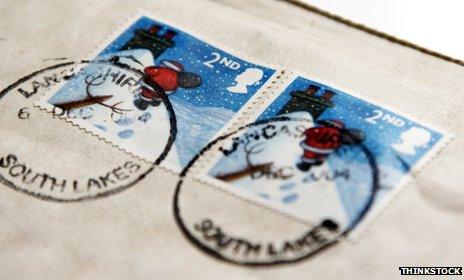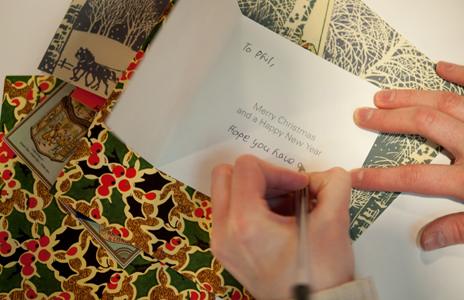10 common Christmas card dilemmas
- Published

It's the season to send Christmas cards - but the festive postbag can also be a social and ethical minefield, writes Ed Ram.
1. Buying in bulk
Christmas card sales make charities an estimated £50m per year, according to the Greeting Card Association. And Christmas is surely a time to be charitable. But is bulk-buying 50 identical charity cards a potential social faux pas? If your friends are also friends with each other they will see "their" card on each other's mantelpieces. However, a true friend wouldn't judge you for this, says Simon Garfield, author of To The Letter: A Journey Though a Vanishing World. "You'd have to have a pretty hard heart to think that someone hasn't spent very much or that they've just bought a huge box," Garfield says. "Even if you get two or three of the same ones in the same year, it's absolutely in the Christmas spirit."
2. Round robin revival?
The round robin letter - usually sent out with the Christmas cards - has become something of a seasonal joke. "Darling Theo is doing frightfully well in his eurhythmy lessons at Charterhouse - and little Imogen has gone back to advising Ban Ki-moon at the UN." Simon Hoggart, Guardian columnist and author of The Cat That Could Open the Fridge, a collection of round robin letters, is not a fan. "Round robins are hopeless because either you know the people so well, you're already familiar with their year, or else you don't know them well enough to care," he says. "The latter group find boasting particularly galling. Who wants to know about the exam successes of a teenager whose father you met in Derby 24 years ago?" But in an age where receiving a letter is a rarity, could the round robin be due for a renaissance? "It might now be a case of take what you can get," says Garfield. "Perhaps people should be grateful that they are being written to at all. It's time to bear the annual show of smugness."

3. Another Christmas expense...
The price of individual Christmas cards is rising. In the UK, the average went from £1.52 in 2011 to £1.62 in 2012, according to the Greeting Card Association. And a second class stamp is now 50p. So carefully picking 20 cards to send to friends and family could easily cost in excess of £40, and considerably more if you went for posh paper or an arty design. And £40 is no mean sum. "It's a serious outlay for people who might not have so much money, the elderly for example," warns Garfield. So is it time to ditch the card all together in favour of expressing greetings in a more modern way? Hoggart believes there's a better solution. "Trim your list," he advises. "Get rid of all those people you're no longer in touch with. In the end it's hypocritical to say how good it would be to meet next year - for the 14th time."
4. A bit dated?
In the age of the festive tweet, sending a Christmas card might seem a bizarre and arcane concept to some. With online communication dominating many people's lives, "letter writing is increasingly a dying art", laments Garfield. "But while it is old fashioned, Christmas card-writing is a strong part of the festive tradition - and the one part of letter-writing that looks to be living on." After all, isn't tradition what Christmas is all about?

5. Nativity scene to an atheist?
Today, Christmas is celebrated by atheists, agnostics and believers alike. But should we be concerned that the front of our Christmas cards may be offending those with specific beliefs? Would a Christian be interested in seeing a picture of a bulging Santa reaching for another mince pie? Or alternatively, is it inappropriate to send a Hindu, Jewish or Muslim friend images of a nativity scene? "It's not something to worry about at all," says Sharon Little, chief executive of the Greeting Card Association. She points out that the earliest Christmas cards in the Victorian era featured secular designs such as "pictures of holly or robins". The very earliest Christmas cards, commissioned by Sir Henry Cole and illustrated by John Callcott Horsley in London on 1 May 1843, depicted three generations of a rosy cheeked family, raising a toast to the card's recipient. From a faith perspective, theologian Vicky Beeching says that it's the thought that matters more than the image on the front of the card. "The Christian faith is all about love, and by sending a card you are transmitting love," she says.

6. Address intrusion
This is an era where we're really not used to asking people for their real-world address. It seems strange to send a pre-card text or email containing only the line: "Are you still living at 3 Elderflower Lane?" Worse, it ruins the surprise. "Where do you live?' now feels like rather a personal question," says Garfield. "It's almost an intrusion." But in the social media age, we have more of these long-distance relationships than ever. We're not going to physically see all of our 268 Facebook friends over the festive season. And surely one of the purposes of Christmas cards is to stay in touch with people you care about but for whatever reason can't see much of. "Increasing contact though social media has bought people closer to larger groups. You are more likely to send Christmas cards to those that you are close to but don't see so often," says Little.
7. Will an email do?
Don't be tempted by the e-alternative, Garfield warns. "The worst cards are the electronic ones," he says. Spamming your friends with a picture of your face photo-shopped onto an elf dancing to Gangnam style is no longer OK. Even if it is cheap. Or free. "Five years ago I thought they were quite fun but now you just think they can't even be bothered to get to the shop, go to the post box or buy a stamp," Garfield says.
8. Card/present etiquette
Like greeting someone new without a handshake or a kiss, there is something not quite right about giving a present that isn't accompanied by a card at Christmas. And it almost goes without saying that the card should always be opened before the gift is unwrapped. "It's just nice, isn't it?" says Garfield. "It makes the gift less about the monetary value and more about the effort involved in thinking about someone." However, while cards do seem to be a necessary social norm, they don't always have to take a conventional form, says writer and comedian Arthur Smith. "I used to make my own cards which were usually rather downbeat," he says. One year, he says, they were adorned with a picture of a distressed turkey. Another Christmas, he fashioned his cards from a piece of toilet paper.

9. Do I have to actually write in it?
Lots of cards have a message already printed in them. But "love, Mum" handwritten hastily beneath a generic festive message looks depressing. Then again, what if you don't have time to dream up endless witty notes individually tailored to all of your chums? The point of cards is to show that the sender is thinking about the person that the card is destined for, says Garfield. "I used to get a card from my framing company that spelt my name wrong," he adds. "They just go in the bin." Smith agrees. "If you send them, every message should be different," he says. But he implores: "Please no pictures of your own beaming family."
10. Waste of trees
With 952 million single, non-multipack greeting cards sold in 2012, you might expect that the production of the paper used to make them is having a detrimental impact on the environment. But the GCA argues that 90% of cards come from sustainably-farmed trees. If trees are farmed and harvested in a responsible way then the environmental impact of the greeting card industry is very low, Sharon Little argues. Conservation charity The Woodland Trust says it is not against sending cards, but it urges consumers to be "be careful and not wasteful". "When buying cards, shoppers should only buy those that either say they are 100% recycled or have the Forest Stewardship Council (FSC) symbol printed on the back," a spokesperson says. "This is the only way to guarantee that the paper has come from a sustainable source." The trust also warns that a card being advertised as "sustainably sourced" doesn't always mean it is FSC approved. The FSC says its label is an assurance that the paper has been responsibly sourced from well-managed forests, verified recycled materials and/or other controlled sources.
Follow @BBCNewsMagazine, external on Twitter and on Facebook, external